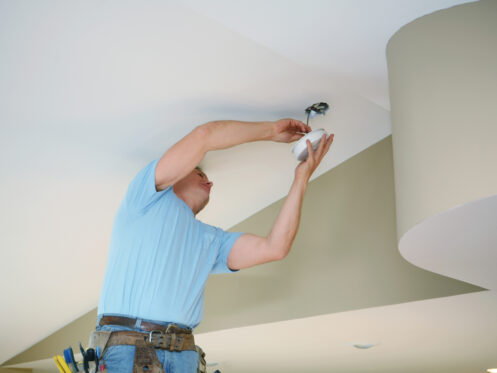People get carbon monoxide poisoning when they breathe in too much of the gas, which is colorless, doesn’t have a smell and has no flavor. It’s the result of incomplete combustion of various fuels, such as wood, gasoline, propane, natural gas and oil. Inhaled carbon monoxide depletes oxygen levels in the blood, which affects important organs, including the heart and brain.
Signs of Carbon Monoxide Poisoning
Carbon monoxide poisoning symptoms are similar to those of other prevalent illnesses, making a diagnosis difficult. Headaches, vertigo, weakness, nausea, vomiting, chest discomfort and disorientation are common symptoms. In severe cases, individuals may experience difficulty breathing, loss of consciousness and seizures. Without adequate medical intervention, it is possible to die from carbon monoxide poisoning.
Infants, the elderly and individuals with pre-existing health conditions are particularly vulnerable to the effects of carbon monoxide poisoning. The presence of comparable symptoms in more than one person in the home or the improvement of symptoms while outside the house should raise the suspicion of carbon monoxide poisoning.
What to Do if You Have Carbon Monoxide Poisoning
If you ever suspect a carbon monoxide leak, quickly get out of the house and stay outside. Do not go back in until someone with training in carbon monoxide detection tells you it’s safe to do so. If you or someone in your home experiences symptoms of carbon monoxide poisoning, you should seek immediate medical attention by calling 911 or a poison control center.
How Does Carbon Monoxide Affect Pets?
Just like us, pets can die from carbon monoxide poisoning if they are around too much of the gas. Symptoms in dogs and other pets can range from weakness, a lack of coordination, vomiting, trouble breathing and lethargy. Animals left in enclosed spaces with inadequate ventilation, such as garages or vehicles, are particularly at risk.
If you suspect your pet has carbon monoxide poisoning, immediately remove them from the area and take them to a well-ventilated area outdoors. Contact your veterinarian or an emergency veterinary clinic for guidance and assistance.
How Does Carbon Monoxide Get Into the Home?
There are a number of ways carbon monoxide can build up in a house, making the structure dangerous for everyone living there. Household appliances like water heaters, stoves, fireplaces and generators can all contribute to the problem by burning fuels incompletely. Inadequate or clogged ventilation systems, together with poorly maintained or malfunctioning equipment, can also leak gas into the air.
Vehicle exhaust fumes, when released into residential rooms via open windows, doors or shared ventilation systems, may contribute to carbon monoxide accumulation in linked garages. Charcoal grills and camp stoves, when used inside or in confined quarters, can also produce harmful amounts of carbon monoxide.
Ways to Protect the Home Against Carbon Monoxide
Thankfully, you can avoid carbon monoxide poisoning in a few different ways. Taking preventative measures to safeguard your house and loved ones is where it all begins.
Use Carbon Monoxide Detectors
Carbon monoxide detectors come in various types, including plug-in, battery-operated and hardwired models. Plug-in detectors are convenient and easy to install, plugging directly into electrical outlets. Detectors that run on batteries are ideal for homes without access to wall outlets because of their portability and versatility. In the event of a power loss, hardwired detectors continue to function thanks to their connection to the home’s electrical system and any backup batteries they may have.
To use carbon monoxide detectors effectively, you must install them according to the manufacturer’s instructions in areas where gas buildup is most likely to occur. If your detector runs on batteries, you should change the batteries often. If it doesn’t, you should replace the device as the manufacturer suggests, usually every five to seven years. This will keep your detector working at its best and keep you safe. Pressing the test button on detectors on a regular basis checks their functionality.
The best places to install carbon monoxide detectors include:
- Basement
- Hallways
- Utility room
- Near sleeping areas
- On each floor
- Near fireplaces
- Attached garages
- Kitchen
- Living room
Ensure Proper Ventilation
Use exhaust fans in kitchens and bathrooms to remove pollutants and moisture from the indoor air. When weather permits, open windows to increase ventilation and allow fresh air to circulate throughout your home. To achieve optimal airflow, open windows on opposite sides of your home to create cross-ventilation.
To prevent exhaust fumes from getting into the house, make sure that linked garages have enough ventilation. Have chimneys and flues inspected and cleaned regularly to prevent blockages and ensure proper venting of combustion gases. Consider installing trickle vents in windows to provide continuous ventilation while maintaining security.
Be Smart With Fuel-Burning Appliances
Place detectors near fuel-burning appliances and sleeping areas to provide early warning of any gas buildup. Always follow the manufacturer’s instructions for the proper installation, operation and maintenance of these appliances. Properly venting fuel-burning equipment to the outside is essential to avoiding the buildup of gas inside the home. Avoid using gas stoves or ovens as a primary heat source, as this can lead to carbon monoxide buildup in the home. Only use portable generators outdoors in well-ventilated areas, away from windows, doors and vents.
Invest in Regular HVAC Maintenance
You can greatly reduce your risk of carbon monoxide poisoning by keeping up with routine HVAC maintenance to keep heating systems running safely and effectively. During routine maintenance, HVAC professionals check and clean components, including vents, boilers and furnaces, to make sure they are free of obstructions.
Looking for corrosion or cracks in the heat exchanger is another important part of HVAC maintenance. The release of carbon monoxide into the home’s air supply due to a broken heat exchanger is a major threat to the health of those living there. To further guarantee adequate ventilation and the exhaust of combustion gases, professionals also examine venting systems, chimneys and flues.
HVAC technicians will also check and test HVAC safety controls during maintenance visits. To avoid the emission of carbon monoxide gas into the house, gas-powered heating systems include flame detectors that turn off the system if they don’t detect a flame. Similarly, limit switches monitor the temperature of heat exchangers and shut off the system if temperatures exceed safe levels, preventing overheating and potential gas leaks.
Schedule Regular Indoor Air Quality Testing
During air quality testing, professionals assess various factors contributing to indoor air quality, including carbon monoxide levels, ventilation and potential sources of pollution. By detecting elevated CO levels early, you can take corrective action to address the issues before they pose a health risk. Comprehensive air quality testing can also identify other pollutants and allergens, ensuring a healthier indoor environment. You should try to schedule indoor air quality testing at least once a year or whenever there are changes to the home’s heating, ventilation or combustion systems.
Are you ready to make your home safer by protecting it against carbon monoxide leaks? Cozy Home Services can help install detectors and perform air quality testing. We also help Vacaville, CA homeowners with plumbing repairs, gas line installations, HVAC services, electrical upgrades, solar panels and more.



